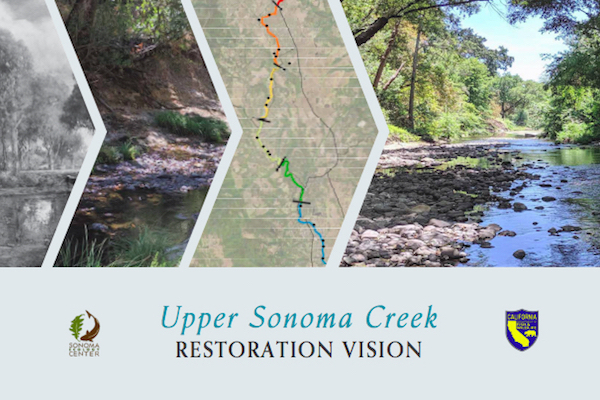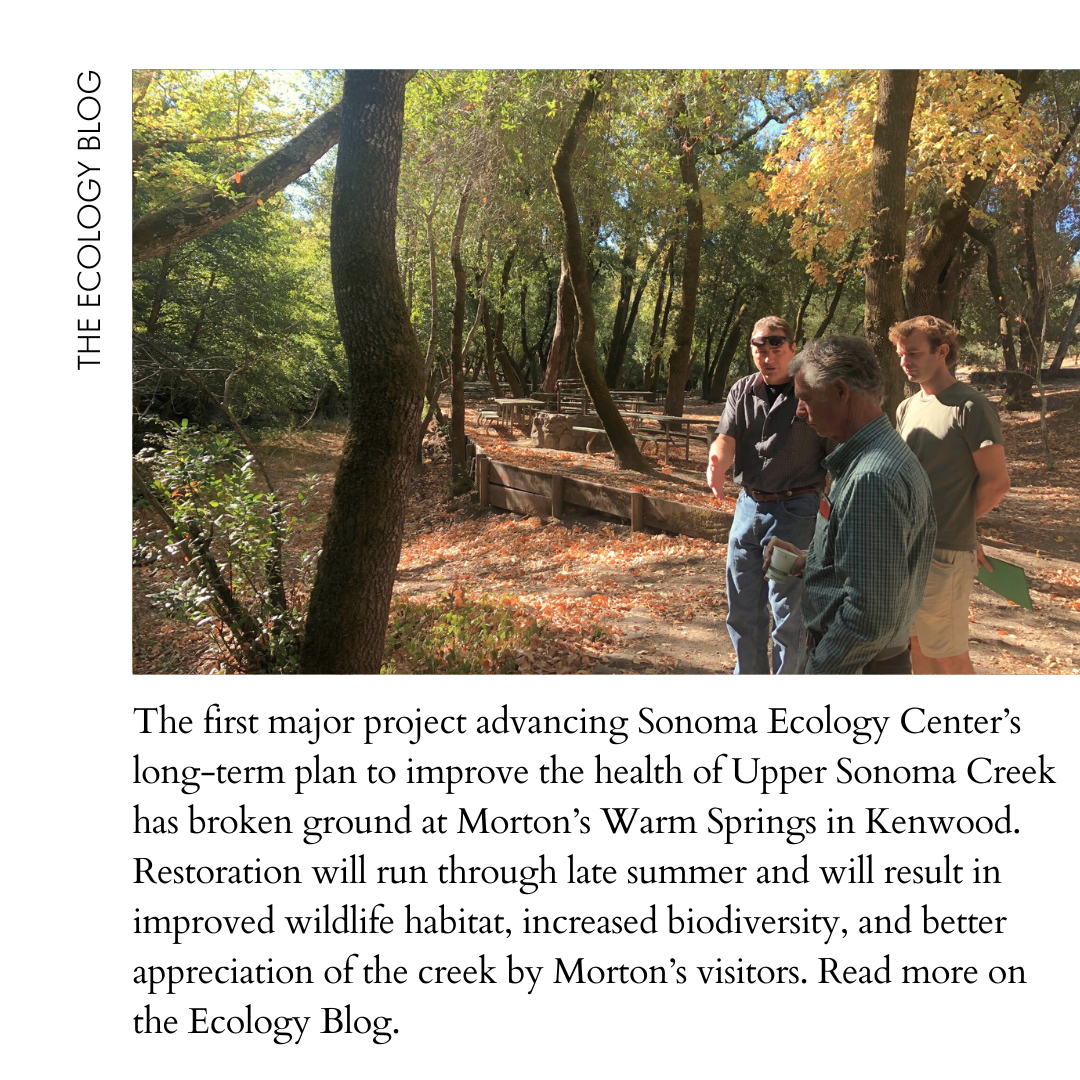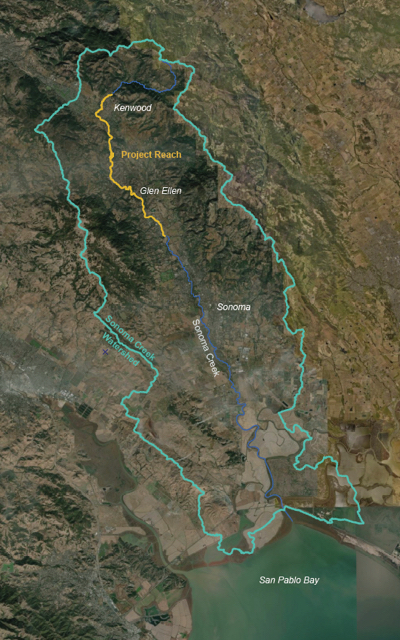Upper Sonoma Creek Restoration Vision
Sonoma Ecology Center’s goal with the Upper Sonoma Creek Restoration Vision is to work with the Sonoma Creek community to identify and design ways to improve steelhead/salmonid habitat through engaging landowners in voluntary restoration.
June 2024: Sonoma Ecology Center Begins Creek Restoration at Morton’s Warm Springs
The Upper Sonoma Creek Restoration Vision Report
 Click on the report to view full PDF.
Click on the report to view full PDF.
As part of our work in implementing the Upper Sonoma Creek Restoration Vision, we published a report that creates a vision for the upper reaches of Sonoma Creek—with key input from the community—for how to improve habitat for steelhead, reduce bank erosion and loss of property, and improve water quality and riparian habitat and all the biodiversity that it supports.
Our first step in creating this vision was to meet with people living along the creek between Madrone Road and Adobe Canyon through a series of community meetings, asking creekside residents and land managers their main concerns (erosion topped the list) as well as their thoughts on creek restoration and riparian management. We also collected input through other outreach including an online Creek Survey.
The project research included a review of previous studies of the watershed, landscape analysis of the creek topography, and field visits to evaluate and prioritize potential locations for restoration actions that will address both the causes and the symptoms of salmonid decline. Through the combination of landowner outreach and technical research, the project identified 20 sites with restoration potential and developed conceptual plans for 16 sites based on landowner input and interest. This Restoration Vision represents the project team’s synthesis of previous studies, historic and existing conditions, and restoration opportunities.
The report was researched, written and designed by Sonoma Ecology Center and Environmental Science Associates, with funding from the California Department of Fish and Wildlife and with immeasurable help from community members.
Project Goals
 The primary goal of the project is to improve spawning conditions for adult steelhead along with winter and summer rearing habitat for juvenile steelhead. While this may appear to be a narrow goal, steelhead can be thought of as an “umbrella” species: restoring spawning and rearing habitat for juvenile steelhead would entail restoring a wide range of interrelated species and habitats, from the gravel-dwelling invertebrates on which steelhead and other aquatic animals feed to the trees that shade them. Reducing bank incision and fine sediment erosion that buries gravels is critical to restoring steelhead habitat.
The primary goal of the project is to improve spawning conditions for adult steelhead along with winter and summer rearing habitat for juvenile steelhead. While this may appear to be a narrow goal, steelhead can be thought of as an “umbrella” species: restoring spawning and rearing habitat for juvenile steelhead would entail restoring a wide range of interrelated species and habitats, from the gravel-dwelling invertebrates on which steelhead and other aquatic animals feed to the trees that shade them. Reducing bank incision and fine sediment erosion that buries gravels is critical to restoring steelhead habitat.
Several secondary objectives will help us meet the primary goal. These include:
- Slow Water: create places where runoff can be retained before entering Sonoma Creek, to reduce flooding, increase groundwater infiltration in the winter and create more sustained summer baseflows in the creek.
- Improve Water Quality: take measures to reduce water temperature, contaminants, pathogens, and fine sediment.
- Reduce Bank Erosion: restore natural sediment dynamics that promote the deposition of coarse sediment (for spawning and supporting the invertebrates that salmonids eat) while reducing erosion that generates fine sediment, burying spawning gravel.
- Improve Riparian Habitat: restore native vegetation, expand the riparian corridor, restore seasonal wetlands.
Background
Historically, upper Sonoma Creek was a vibrant river corridor bordered by many seasonal and perennial wetlands that supported significant runs of steelhead, Chinook salmon and Coho salmon. Today, there are only small runs of steelhead and Chinook salmon. Investigations into the decline of the salmonid runs led to Sonoma Creek being listed as impaired due to excessive fine sediment in 1996, and the 2006 Limiting Factors Analysis (LFA) identified channel erosion as the main source of fine sediment. Channel erosion was also found to be degrading the in-channel habitat for salmonid spawning and rearing, while fish migration barriers and lack of cold water during the summer were found to be impacting summer rearing by steelhead. The LFA identified the need to counter the impacts of development on the ecosystem by restoring degraded summer and winter rearing habitat by redeveloping channel complexity and instream shelter. The Upper Sonoma Creek Habitat Restoration Project is the planning phase of a project to protect and restore habitat for steelhead and Chinook salmon.
Questions or suggestions? Contact us at creek@sonomaecologycenter.org.


